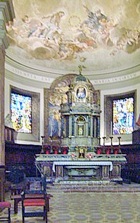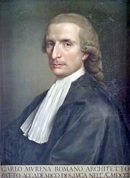
Portrait (18th century) of Carlo Murena by Anton van Maron
Galleria dell'Accademia Nazionale di San Luca
Carlo Murena was born in what is now called Collalto Sabino, some 80 km from Rome. He trained in Rome under Luigi Vanvitelli from ca. 1737, and benefitted greatly from his subsequent support. It was through his good offices that Murena was given his first important commission, at the Convento di Montemorcino Nuova, Perugia (see below) in 1740. In return, Carlo Murena managed Vanvitelli’s affairs in Rome when he was engaged elsewhere.
Carlo Murena was elected to the Accademia di San Luca in Rome in 1759. Giuseppe Piermarini moved from Foligno to Rome in 1752 to study architecture under him, before moving to Caserta in 1765 to work under Luigi Vanvitelli
Foligno
SS Trinità in Annunziata (1760)
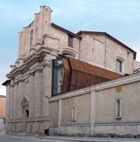
Gubbio
Ospedale Grande (1746-66)
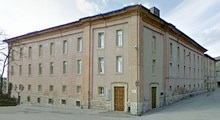
Discussion of the need for a new hospital in Gubbio began in 1709. However, it only became a possibility after a bequest from the Marchese Gioia della Rena. In 1746, the design was commissioned from Carlo Murena and Antonio Francesco Berardi di Cagli for a site next to the existing hospital in what was then Piazza del Mercato. The foundation stone was laid in 1749 and the project was completed in 1766.
Perugia
Monastero degli Olivetani di Montemorcino Nuovo (1740)
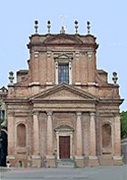
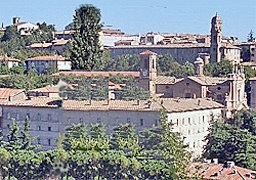
Luigi Vanvitelli designed the church and the huge adjacent monastery known as the Convento di Montemorcino Nuova for two communities of Olivetan monks that moved to this site in 1740:
-
✴one from Montemorcino (to the west of Perugia); and
-
✴the other from Sant' Antonio Abate, in the city.
It was through his good offices that the young Carlo Murena was appointed as director of the construction project. The complex was transferred to the University of Perugia in 1811. The church (which is dedicated to Santa Maria Annunziata) was restored and re-opened as the university church. Its neo-Classical façade dominates what is now Piazza dell’ Università.
High Altar of the Duomo (1761-2)
Bishop Francesco Riccardo Ferniani consecrated the new high altar of the Duomo, which was designed by Carlo Murena and built by Francesco Caselli.
Terni
Tabernacle (1762)


